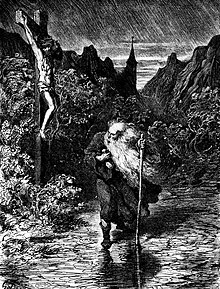방황하는 유대인

방황하는 유대인(프랑스어: Le juif errant)은 13세기 유럽에서 퍼지기 시작한 전설 속의 허구적 인물이다.[1] 원 전설에 따르면, 그는 예수가 십자가형에 처해질 때 그를 모독하던 유대인이었으며, 저주를 받아 재림 전까지 죽지 못하고 세계를 걸어다니며 떠돌아야 하는 운명에 처해졌다고 전해진다.
이 전설의 성경적 근거로써 성경의 호세아서 9장 17절의 "그들이 듣지 아니하므로 내 하나님이 그들을 버리시리니 그들이 여러 나라 가운데에 떠도는 자가 되리라"라는 구절을 인용하기도 한다.
같이 보기[편집]
- 사람의 아들 (소설) : 소설 중 아하스 페르츠는 방황하는 유대인을 의미
참고 문헌[편집]
- Anderson, George K. The Legend of the Wandering Jew. Providence: Brown University Press, 1965. xi, 489 p.; reprint edition ISBN 0-87451-547-5 Collects both literary versions and folk versions.
- Hasan-Rokem, Galit and Alan Dundes The Wandering Jew: Essays in the Interpretation of a Christian Legend (Bloomington:Indiana University Press) 1986. 20th-century folkloristic renderings.
- Manning, Robert Douglas Wandering Jew and Wandering Jewess ISBN 978-1-895507-90-4
- Gaer, Joseph (Fishman) The Legend of the Wandering Jew New American Library, 1961 (Dore illustrations) popular account.
- Richard I. Cohen, "The "Wandering Jew" from Medieval Legend to Modern Metaphor," in Barbara Kirshenblatt-Gimblett and Jonathan Karp (eds), The Art of Being Jewish in Modern Times (Philadelphia, University of Pennsylvania Press, 2007) (Jewish Culture and Contexts),
각주[편집]
- ↑ as described in the first chapter of Curious Myths of the Middle Ages where Sabine Baring-Gould attributed the earliest extant mention of the myth of the Wandering Jew to Matthew Paris. The chapter began with a reference to Gustave Doré's series of twelve illustrations to the legend, and ended with a sentence remarking that, while the original legend was so 'noble in its severe simplicity' that few could develop it with success in poetry or otherwise, Doré had produced in this series 'at once a poem, a romance, and a chef-d'oeuvre of art'. First published in two parts in 1866 and 1868, the work was republished in 1877 and in many other editions.[1]
외부 링크[편집]
- Wandering Jew and Jewess dramatic screenplays
- The Wandering Jew, by Eugène Sue - 프로젝트 구텐베르크
- Catholic Encyclopedia entry
- The (presumed) End of the Wandering Jew from The Golden Calf by Ilf and Petrov
- Israel's First President, Chaim Weizmann, "A Wandering Jew"[깨진 링크(과거 내용 찾기)] Shapell Manuscript Foundation
- "The Wandering Image: Converting the Wandering Jew" Iconography and visual art. Archived 2017년 11월 9일 - 웨이백 머신
- "The Wandering Jew," and "The Wandering Jew's Chronicle" English Broadside Ballad Archive
